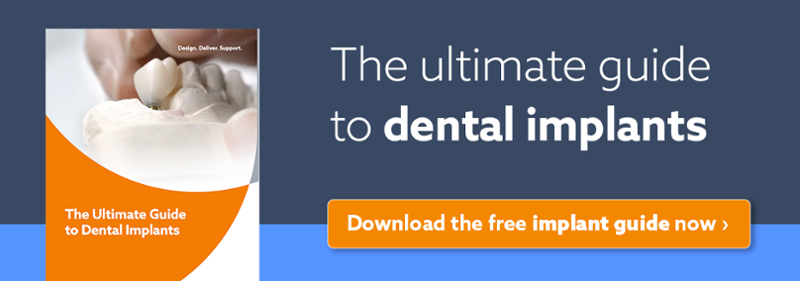Despite improved dental care over the past few decades, edentulism is still common among elderly patients. Complete edentulism, which is often a consequence of caries, poor oral hygiene, and periodontal disease, has a detrimental effect on the patient’s oral and general health and overall sense of well-being. Dentures are the conventional treatment for edentulism. Data suggests that the number of adults in need of dentures in the United States will increase from more than 35 million in 2000 to 37 million by 2020. Clinical studies have also shown that patients supplied with dentures can expect only a marginal increase in quality of life compared to patients who receive implant therapy.
Unfortunately, not every patient can have conventional implant treatment, which requires multiple implants to restore a complete arch of teeth. As life expectancies increase, clinicians are faced with providing reliable, affordable solutions for patients who might not want (or be able to undergo) lengthier implant treatments in which multiple implants, bone augmentation, or soft tissue regeneration are required. All-on-four provides an alternative solution.
When to Suggest All-On-Four
All-on-four is a treatment concept that provides patients with an immediately-loaded prosthesis supported by four dental implants. It is particularly effective for patients with poor bone quality or volume or where bone augmentation would be challenging or inadvisable. All-on-four allows for the placement of physically longer implants that provide greater anchorage and support and preserve anatomical structures. Tilting the distal implants maximizes use of available bone while reducing the cantilever length in the jaw. Several studies have found that tilting these implants produces reliable clinical outcomes.
As patients become more aware of their options they may request this treatment without understanding what is involved or how exactly it can benefit them. This treatment provides a predictable outcome, giving patients a high level of satisfaction in terms of functionality and esthetics. While it can be an excellent option, there are several factors worth discussing with the patient when suggesting it as a possible solution.
The Potential Bulkiness of an All-On-Four Bridge
Some people find it difficult to adapt to the feel of an all-on-four bridge because of its bulkier design. If they are only expecting to obtain replacement teeth, it might be a shock to also feel replacement gum tissue. Showing them models of conventional full-arch bridges compared with an all-on-four bridge will help them adjust to the idea and prepare them for the look and feel of their new bridge after surgery. If they have concerns, you can always discuss alternative treatments. Many patients choose all-on-four because of its affordability but will be more willing to pursue alternative treatments when they have been fully informed of all their treatment options.
Changes to Speech
Often with all-on-four it is necessary to replace bone and soft tissue in addition to teeth. For the strength of the implant the bridge will likely need to be bulkier than the patient’s original tissues. The increase in bulk affects speech but, in time, this can be overcome by retraining the tongue. The patient may initially find it more difficult to clearly enunciate sounds produced when the tongue contacts the hard palate, just above the central upper incisors. Difficult sounds include “N,” “D,” and “T.” They might also find it more difficult to clearly produce “S” sounds.
If speech is a particular concern, it could cause anxiety, and the patient might prefer to consider less bulky alternative treatments. One option is to try to save some natural teeth, instead providing a bridge that only replaces teeth that are no longer viable. Saving natural teeth is likely to increase the cost and time required for treatment. Alternative treatment options might require additional implants and bone grafting. If some natural teeth are saved, then the patient must understand the importance of caring for these teeth, especially when natural teeth have been lost due to neglect or disease. Some patients may be unable or unwilling to change their habits, in which case an overdenture provides a simplified oral hygiene routine.
Parafunction and Proprioception
Parafunctional habits, including bruxism, could affect the options you recommend to the patient. Implants, especially duil-arch all-on-four restorations, don’t detect forces as easily as natural teeth. Periodontal mechanoreceptors increase the sensitivity of natural teeth to forces, and dental implants lose this feedback. When both arches require treatment, it may be worth trying to save at least a few natural teeth in order to register these forces. Otherwise consider restoring the maxilla first, so the patient can more easily learn when they are using excessive force.
Restoring one arch at a time gives the patient a chance to develop mechanoreceptors in their facial muscles and joints. Another option is to use a bar-supported overdenture. While still an all-on-four procedure, the prosthesis will obviously not be fixed. This means the overdenture can be removed at night and replaced with a night guard that will snap onto the bar, providing protection for bruxers. However, for many people the appeal of all-on-four lies in having a fixed arch prosthesis, so the bar-supported overdenture may initially seem less attractive.
Despite the possible limitations of all-on-four implant treatments, these dental implants offer great potential for significantly improving the quality of life for edentulous patients when compared with conventional dentures. If you currently have elderly patients who are struggling with poor denture stability, discomfort, and difficulties eating, then all-on-four could be a suitable and affordable treatment choice. All-on-four offers a predictable outcome, is less invasive, and is easier for an older patient with other health concerns to tolerate. When helping the patient choose a treatment, it’s necessary to discuss all possible choices so that they feel satisfied and able to make the correct decision for their needs.
Our experienced technical team is here to assist you should you wish to discuss a case in more detail.
Click here to schedule a consultation with our technical team »

References:
http://www.dentistryiq.com/articles/2017/11/when-is-all-on-4-the-best-option-5-factors-to-consider-when-creating-your-dental-treatment-plan.html
http://www.joionline.org/doi/full/10.1563/AAID-JOI-D-10-00133?code=aaid-premdev